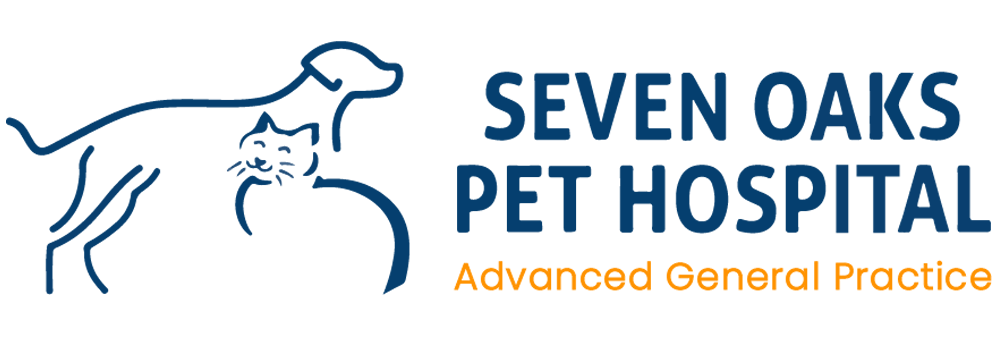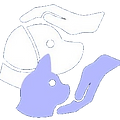Perineal Hernia
To download and print this information, please click here.
Perineal Hernia occurs when pelvic diaphragm muscles fail to support the rectal wall, allowing persistent rectal distention and impaired defecation. Pelvic and or abdominal contents herniate into the deviation.
The cause of pelvic diaphragm weakening is poorly understood but is believed to be associated with male hormones, straining, and congenital or acquired muscle weakness or atrophy. The pelvic diaphragm is stronger in female dogs than in males. Atrophy of the pelvic diaphragm muscles, possibly of neurologic origin, has been identified in some animals with hernias.
Conditions That Cause Straining and May Predispose to Perineal Herniation
- Prostatitis
- Cystitis
- Urinary tract obstruction
- Colorectal obstruction
- Rectal deviation or dilation
- Perianal inflammation
- Anal sacculitis
- Diarrhea
- Constipation
Herniation may be unilateral or bilateral. Most herniations occur between the levatorani, external anal sphincter, and internal obturator muscles (caudal hernia); however, some occur between the sacrotuberous ligament and coccygeus muscle (sciatic hernia), levatorani and coccygeus muscles (dorsal hernia), or ischiourethralis, bulbocavernosus, and ischiocavernosus muscles (ventral hernia).
Hernial contents are surrounded by a thin layer of perineal fascia (hernial sac), subcutaneous tissue, and skin. The hernial sac may contain pelvic or retroperitoneal fat, serous fluid, a deviated or dilated rectum, a rectal diverticulum, prostate, urinary bladder, or small intestine.
Cats usually have only rectum within the hernial sac.
Organs displaced into the hernia may become obstructed and strangulated. Visceral obstruction or strangulation is associated with rapid deterioration unless the obstruction or entrapment is corrected
Signalment
- Perineal hernias are common in dogs and rare in cats. They occur almost exclusively in intact male dogs (93%).
- Perineal hernias in female dogs are often related to trauma.
- Feline perineal hernias usually occur in neutered males; however, female cats are more prone to perineal hernias than female dogs.
- Dogs with short tails may be predisposed to herniation. Breeds most commonly affected are Boston terriers, boxers, Welsh corgis, Pekingese, collies, poodles, kelpies, dachshunds, Old English sheepdogs, and mongrels.
- Most perineal hernias occur in dogs over 5 years of age. The median age is approximately 10 years in both dogs and cats. The risk of occurrence increases with age until 14 years in intact male dogs.
- Affected animals usually are presented for treatment because of difficulty defecating. Some owners notice a swelling lateral to the anus. Occasionally, animals are presented as emergencies because of postrenal uremia associated with bladder entrapment or shock associated with intestinal strangulation
Clinical signs
Clinical signs may include perineal swelling, constipation, obstipation, dyschezia, tenesmus, rectal prolapse, stranguria, anuria, vomiting, flatulence, and/or fecal incontinence.
Physical Examination Findings
- The diagnosis is based on finding a weakened pelvic diaphragm during a digital rectal examination, with or without a perineal swelling lateral to the anus
- Not all dogs with perineal hernias have perineal swelling. When present, the swelling may appear to surround the anus and cause it to bulge.
- A rectal deviation often contains impacted feces. Some reports indicate a right-sided predominance.
- Cats typically have bilateral hernias, which seldom cause obvious perineal swelling.
- The prostate sometimes is found in the hernia. Severe straining can cause rectal prolapse. Some animals are systemically ill and shocky because of visceral strangulation.
- If ballottement suggests that liquid is present and the animal is dysuric, ultrasound or peritoneocentesis should be performed to determine if fluid (i.e., urine) is present.
- A hernia filled with a full bladder may have a tight, resilient feel when palpated, instead of a fluid wave. Concurrent inguinal hernias have been identified in some dogs with perineal hernia.
- Survey radiographs are seldom needed for diagnosis; however, they are useful in ascertaining whether the urinary bladder, prostate, or small intestines are in the hernia.
- Radiographically documenting retroflexion of the urinary bladder often requires aurethrogram, cystogram, or both or the use of ultrasonography.
- Administration of oral or rectal barium demonstrates the position of the colon and rectum. Most dogs have rectal deviation and some also have rectal dilatation.
- Patients with bladder retroflexion often have azotemia, hyperkalemia, hyperphosphatemia, and neutrophilic leukocytosis.
Differential diagnoses for perianal swelling include perineal hernia, perianal neoplasia, perianal gland hyperplasia, anal sacculitis, anal sac neoplasia, atresia ani, and vaginal tumors.
Differential diagnoses for dyschezia include rectal foreign body, perineal hernia, perianal fistula, anal stricture, rectal stricture, anal sac abscess, rectal neoplasia, anal neoplasia, anal trauma, anal dermatitis, rectal pythiosis, and anorectal prolapse.
MEDICAL MANAGEMENT
The goal of treatment is to relieve and prevent constipation, dysuria, and organ strangulation. Causative factors (i.e., urinary tract obstruction or infection, megacolon, and prostatitis) should be corrected. Normal defecation sometimes can be maintained using laxatives, stool softeners, dietary changes, periodic enemas, and/or manual rectal evacuation. The urinary bladder can be decompressed by centesis or catheterization.
However, long-term use of these treatments is contraindicated because life-threatening visceral entrapment and strangulation may occur.
SURGICAL TREATMENT
Herniorrhaphy should always be recommended. Retroflexion of the urinary bladder and visceral entrapment require emergency surgery. Castration is recommended during herniorrhaphy because it has been reported to reduce recurrence. Non-castrated dogs have a recurrence rate 2.7 times greater than castrated dogs.
The two most commonly used surgical techniques:
- The traditional, or anatomic re-apposition
- The internal obturator roll-up, or transposition technique. It is more difficult to close the ventral aspect of the hernia using the traditional technique.
Bilateral herniorrhaphy is possible, but postoperative discomfort and tenesmus may be greater than after unilateral procedures.
Colopexy may help prevent recurrent rectal prolapse after herniorrhaphy.
Fixation of the ductus deferens may help prevent recurrence when the bladder or prostate has been displaced into perineal hernias.
Cystopexy has also been performed, but is not routinely recommended as retention cystitis may occur.
Postoperative Complications:
Postoperative tenesmus and rectal prolapse may be more common in these cases. The internal obturator transposition technique is more difficult, especially if internal obturator muscle atrophy is severe. However, it causes less tension on sutures and less deformity of the anus, and creates a ventral patch or sling for the defect.
Preoperative Management
Stool softeners should be given 2 to 3 days before surgery. The large intestine should be evacuated with laxatives, cathartics, enemas, and manual extraction. Prophylactic antibiotics effective against gram-negative and anaerobic organisms should be given intravenously after induction of anesthesia. If the urinary bladder is retroflexed into the hernia, a urinary catheter should be placed or cystocentesis performed via the perineum to relieve distress and prevent further physiologic deterioration.
Positioning
Clip and aseptically prepare the perineum for surgery. The prepared area should extend 10 to 15 cm cranial to the tail base, laterally beyond the ischial tuberosity, and ventrally to include the scrotum.
The animal should be positioned in ventral recumbency with the tail fixed over the back, the pelvis elevated, and the hind legs padded.
SURGICAL TECHNIQUES
Make a curvilinear incision beginning cranial to the coccygeus muscles, curving over the hernial bulge 1 to 2 cm lateral to the anus, and extending 2 to 3 cm ventral to the pelvic floor). Incise the subcutaneous tissue and hernial sac. Identify and reduce the hernial contents by dissecting subcutaneous and fibrous attachments. Biopsy any abnormal structures within the hernia (e.g., prostate and masses). Maintain hernial reduction by packing the defect with a moistened, tagged sponge. Identify the muscles involved in the hernia, the internal pudendal artery and vein, the pudendal nerve, the caudal rectal vessels and nerve, and the sacrotuberous ligament. Repair the hernia with one of the described techniques. After herniorrhaphy, perform a caudal castration through a median perineal incision
1. Traditional (Anatomic) Herniorrhaphy
Preplace simple interrupted 0 or 2-0 monofilament sutures using a large, curved needle Begin suture placement between the external anal sphincter and the levatorani, coccygeus, or both muscles. Space sutures less than 1 cm apart. As placement progresses ventrally and laterally, incorporate the
sacrotuberous ligament for a secure repair if necessary.
2. Internal Obturator Transposition Herniorrhaphy
Incise the fascia and periosteum along the caudal border of the ischium and origin of the internal obturator muscle. Using a periosteal elevator, elevate the periosteum and internal obturator muscle from the ischium Transpose dorsomedially or roll up the muscle into the defect to allow apposition between the coccygeus, levatorani, and external anal sphincter. Transect the internal obturator tendon of insertion, if necessary, to get adequate coverage of the defect. The internal obturator tendon often is difficult to visualize, making transection difficult. Take care to prevent transection of the caudal gluteal vessels and perineal nerve. Preplace simple interrupted sutures the same as with the traditional technique. Begin by apposing the combined levatorani and coccygeus muscles with the external anal sphincter muscle dorsally. Then place sutures between the internal obturator and external anal sphincter medially and the levatorani and coccygeus muscles laterally.
POSTOPERATIVE CARE AND ASSESSMENT
- Analgesics should be given as necessary to minimize straining and rectal prolapse.
- If rectal prolapse occurs, a purse-string suture should be placed. Recurrent rectal prolapse may be prevented by performing a colopex
- Cold compresses applied immediately after surgery and two to three times daily for 15 to 20 minutes during the first 48 to 72 hours minimize hemorrhage and inflammation.
- After 48 to 72 hours, warm compresses applied to the surgical site two or three times daily for 15 to 20 minutes to reduce swelling and perianal irritation.
- After herniorrhaphy, patients should be monitored for signs of wound infection (i.e., redness, pain, swelling, or discharge).
- Stool softeners should be continued for 1 to 2 months.
- The animal should be fed a canned diet high in fiber.
Post-Operative Perineal Hernia Repair
COMPLICATIONS:
Possible Complications of Perineal Herniorrhaphy
- Hemorrhage
- Depression
- Anorexia
- Tenesmus
- Dyschezia
- Flatulence
- Hematochezia
- Rectal prolapse
- Anal sacculitis
- Fecal incontinence
- Urethral damage
- Dysuria
- Stranguria
- Bladder atony
- Bladder necrosis
- Urinary incontinence
- Intestinal necrosis
- Rectocutaneous or perineal fistula
Most postoperative complications can be prevented by meticulous surgical technique. Hernia recurrence or contralateral herniation is believed to be reduced by castration during herniorrhaphy
Recurrence is related to the expertise of the surgeon; inexperienced surgeons have higher recurrence rates. Infection and dehiscence usually can be prevented by appropriate antibiotic prophylaxis & surgical technique.
PROGNOSIS
- Defecation in affected patients is facilitated by medical and dietary management. The danger of prolonged medical therapy is that the bladder, intestine, or prostate will become trapped in the hernia, causing life-threatening consequences.
- Surgery is successful 80% of the time.
- The prognosis is fair to good when surgery is performed by an experienced surgeon.
- Patients with bladder retroflexion have the poorest prognosis.



